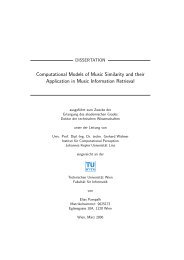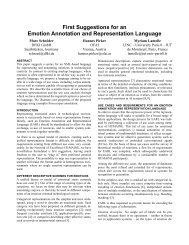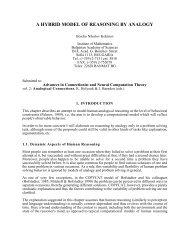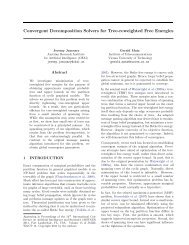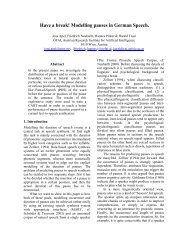Global Musical Tempo Transformations using Case Based ... - OFAI
Global Musical Tempo Transformations using Case Based ... - OFAI
Global Musical Tempo Transformations using Case Based ... - OFAI
You also want an ePaper? Increase the reach of your titles
YUMPU automatically turns print PDFs into web optimized ePapers that Google loves.
P<br />
D ID IP VP R IR VR<br />
¡ ¢<br />
Figure 3.5: Eight of the basic structures of the I/R model.<br />
other words, some notes are more likely to follow the two heard notes than<br />
others. Two main principles recognized by Narmour concern registral direction<br />
and intervallic difference. The principle of registral direction states that<br />
small intervals imply an interval in the same registral direction (a small upward<br />
interval implies another upward interval, and analogous for downward<br />
intervals), and large intervals imply a change in registral direction (a large<br />
upward interval implies another upward interval and analogous for downward<br />
intervals). The principle of intervallic difference states that a small<br />
(five semitones or less) interval implies a similarly-sized interval (plus or minus<br />
2 semitones), and a large intervals (seven semitones or more) implies a<br />
smaller interval.<br />
<strong>Based</strong> on these two principles, melodic patterns can be identified that<br />
either satisfy or violate the implication as predicted by the principles. Such<br />
patterns are called structures and labeled to denote characteristics in terms<br />
of registral direction and intervallic difference. Eight such structures are<br />
shown in figure 3.5. The P structure (‘Process’) is a small interval followed<br />
by another small interval (of similar size), thus satisfying both the registral<br />
direction principle and the intervallic difference principle. The D structure<br />
also continues in the same direction (lateral) with a similar interval (the unison).<br />
The IP (‘Intervallic Process’) is a structure that satisfies the intervallic<br />
difference principle (since the small interval implied by the initial small interval<br />
is realized), but violates the registral direction principle (since the small<br />
interval implies a continuation in the same direction). Conversely, VP (‘Vector<br />
Process’) satisfies registral direction and violates intervallic difference. In<br />
the same way, the R (‘Reversal’) structure satisfies both principles, and has<br />
two counter-parts IR and VR where one of the principles is violated. The ID<br />
structure (‘Identity’), appeals to another principle, registral return, that we<br />
will not discuss here.<br />
Additional principles are assumed to hold, one of which concerns closure,<br />
which states that the implication of an interval is inhibited when a melody<br />
changes in direction, or when a small interval is followed by a large interval.<br />
Other factors also determine closure, like metrical position (strong metrical<br />
positions contribute to closure, rhythm (notes with a long duration contribute<br />
to closure), and harmony (resolution of dissonance into consonance<br />
contributes to closure).<br />
48




